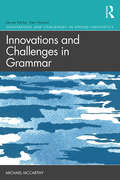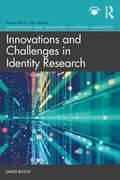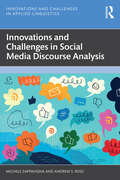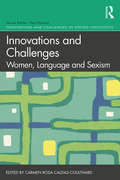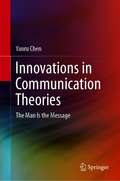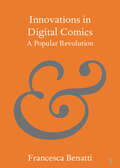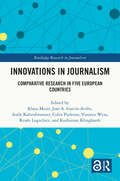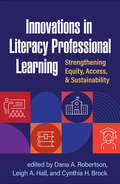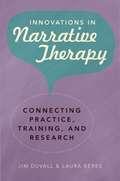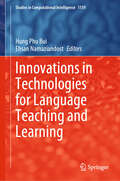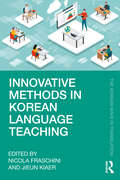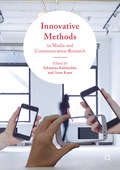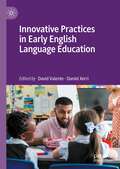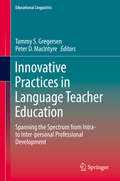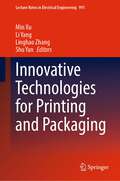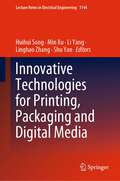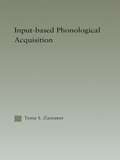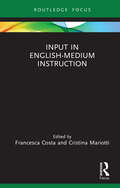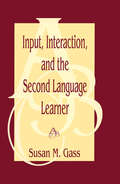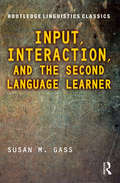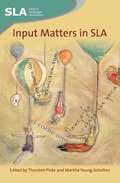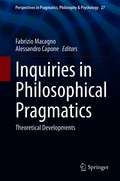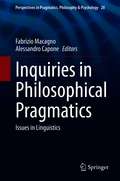- Table View
- List View
Innovations and Challenges in Grammar (Innovations and Challenges in Applied Linguistics)
by Michael MccarthyInnovations and Challenges in Grammar traces the history of common understandings of what grammar is and where it came from to demonstrate how ‘rules’ are anything but fixed and immutable. In doing so, it deconstructs the notion of ‘correctness’ to show how grammar changes over time thereby exposing the social and historical forces that mould and change usage. The questions that this book grapples with are: Can we separate grammar from the other features of the language system and get a handle on it as an independent entity? Why should there be strikingly different notions and models of grammar? Are they (in)compatible? Which one or ones fit(s) best the needs of applied linguists if we assume that applied linguists address real-world problems through the lens of language? And which one(s) could make most sense to non-specialists? If grammar is not a fixed entity but a set of usage norms in constant flux, how can we persuade other professionals and the general public that this is a positive observation rather than a threat to civilised behaviour? This book draws upon both historical and modern grammars from across the globe to provide a multi-layered picture of world grammar. It will be useful to teachers and researchers of English as a first and second language, though the inclusion of examples from and occasional references to other languages (French, Spanish, Malay, Swedish, Russian, Welsh, Burmese, Japanese) is intended to broaden the appeal to teachers and researchers of other languages. It will be of use to final-year undergraduate, postgraduate and doctoral students as well as secondary and tertiary level teachers and researchers in applied linguistics, second language acquisition and grammar pedagogy.
Innovations and Challenges in Identity Research (Innovations and Challenges in Applied Linguistics)
by David BlockInnovations and Challenges in Identity Research examines established and emergent issues within identity research. This innovative book adopts a disciplinary transcendent approach, drawing on a range of social science, humanities and human science disciplines on the way to a detailed consideration of: the history of identity as a construct the components of a poststructuralist/social constructivist approach to identity the prospect of a Marxist political economy approach to identity the interrelationship between structure and agency and a model of structuring spheres an expanded version of positioning theory the digital universe as the future of identity research. Leading researcher David Block provides a personal take on this key topic of study in applied linguistics and explains why and how discourse analysis is still a useful means through which we can understand identity today. The book is essential reading for students and academics studying and researching within the area of language and identity.
Innovations and Challenges in Language Learning Motivation (Innovations and Challenges in Applied Linguistics)
by Zoltán DörnyeiInnovations and Challenges in Language Learning Motivation provides a cutting-edge perspective on the latest challenges and innovations in language learning motivation, incorporating numerous examples and cases in mainstream psychology and in the field of second language acquisition. Drawing on over three decades of research experience as well as an extensive review of the latest psychological and SLA literature, Dörnyei provides an accessible overview of these cutting-edge areas and covers novel topics that have not yet been addressed in L2 motivation research, such as: • fundamental theoretical questions such as mental time travel, ego depletion, psychological momentum and passion, and how the temporal dimension of motivation can be made consistent with a learner attribute; • key challenges concerning the notion of L2 motivation, ranging from issues about the nature of motivation (e.g. trait, state or a process?) and questions surrounding unconscious versus conscious motivation, the motivational capacity of vision, and long-term motivation and persistence; • highly practical classroom-specific challenges such as how technological advances could be better integrated in teachers’ repertoires of motivational strategies. This distinctive book from one of the key voices in the field will be essential reading for students in the field of TESOL and Applied Linguistics, as well as language teachers and teacher educators.
Innovations and Challenges in Social Media Discourse Analysis (Innovations and Challenges in Applied Linguistics)
by Michele Zappavigna Andrew S. RossInnovations and Challenges in Social Media Discourse Analysis provides a key introduction to the analysis of everyday discourse on social media platforms.Outlining the challenges involved in the study of social media discourse that includes social interaction, relationality, intersubjectivity, and intermodality, this book takes a social semiotic approach to offer a useful reconceptualisation of existing tools and introduces new methodologies to help those studying in this area.Drawing on a range of corpora that feature tweets, Instagram photos, YouTube comments, and emoji, this book is essential reading for students studying modules on discourse analysis and language and media.
Innovations and Challenges: Women, Language and Sexism (Innovations and Challenges in Applied Linguistics)
by Caldas-Coulthard Carmen RosaInnovations and Challenges: Women, Language and Sexism brings together an outstanding collection of essays from internationally recognised researchers to recontextualise some of the questions raised by feminist thinkers 40 years ago. By taking linguistically mediated violence as a central topic, this collection’s main objective is to explore the different and subtle ways sexism and violence are materialised in discursive practices. In doing so, this book: Takes a multi-stranded investigation into the linguistic and semiotic representations of sexism in societies from an applied linguistic and semiotic perspective; Combines critical discourse analysis, multimodality, interactional sociolinguistics and corpus methodologies to look at language, visuals and semiotic resources in the context of consumerist culture; Examines the conflicted position of women and the discourses of discrimination that still exist in every strand of modern societies; Contextualises pervasive gender issues and reviews key gender and language topics that changed the ways we interpret interaction from the early 1970s until the present; Focuses on institutional discourses and the questions of how women are excluded or discriminated against in the workplace, the law and educational contexts. Innovations and Challenges: Women, Language and Sexism revisits the initial questions posed by the first feminist linguists – where, when and how are women discriminated against and why, in postmodern societies, is there so much sexism in all realms of social life? This book is essential reading for those studying and researching gender across a wide range of disciplines.
Innovations in Communication Theories: The Man Is the Message
by Yanru ChenThis book offers a novel approach to innovations in theories of communication and social development. It proposes that "the man is the message". It argues that communication is woven into the fabric of people’s daily lives, and a scholar with a keen eye, an open heart and an inquiring mind should be able to capture the ubiquitous phenomena of communication and turn them into theoretical observations and even innovations.Although most of the propositions in this book cannot be tested empirically, at least for now, owing to the limitations inherent in current research methods, they complement the empirical studies of communication based on measurement.With due understanding that Western social sciences, including communication studies, focus on analytical thinking and the fine division of disciplines, this book takes a more synthetic approach to analyzing communication, often integrating and contextualizing its various factors and channels and categories in analysis and writing. Providing a holistic picture of communication that features the crux of the matter—how to reach and capture the heart and soul of people without any attempt to manipulate their minds, it is more humanistic than many other books on communication studies. Although much of the thinking in the book is seemingly Chinese, it nevertheless has a universal appeal.
Innovations in Digital Comics: A Popular Revolution (Elements in Publishing and Book Culture)
by Francesca BenattiThe success of popular webcomics (comics produced and read entirely digitally) is the greatest revolution in the comics medium of the last two decades. Webcomics exploit a socio-technical convergence between digital platforms and participatory cultures, enabling global authors to work together with global audiences to transcend established print comics structures. After defining digital comics, webcomics and webtoons, this Element presents a case study of Korean platform WEBTOON, which achieved 100 billion global page views in 2019. The study analyses data from their website, including views, subscriptions and likes, to quantify and assess whether WEBTOON's commercial and critical success is connected to its inclusion of a wider range of genres and of a more diverse author base than mainstream English-language print comics. In so doing, it performs the first Book Historical study of webcomics and webtoons. This title is also available as Open Access on Cambridge Core.
Innovations in Journalism: Comparative Research in Five European Countries (Routledge Research in Journalism)
by Klaus Meier Jose A. García-Avilés Andy Kaltenbrunner Colin Porlezza Vinzenz Wyss Renée Lugschitz Korbinian KlinghardtThis volume explores innovations in journalism: the goals and expectations associated with them, promoting and hindering framework conditions, and their social and industrial impact.Drawing on an international research project conducted in Germany, Austria, Switzerland, Spain, and the United Kingdom, the book takes a complex approach, considering media policy preconditions and the social impact of journalistic innovation from a comparative perspective. The key findings are examined and presented on different levels: theoretical, methodological, and – as the focus – empirical.Having identified the most relevant innovations in each of the five countries, a total of 100 case studies are examined to explore the influence of these innovations on the quality of journalism and its normative role in democratic societies and to analyze which preconditions support or inhibit the development and implementation of the innovations in news organizations. The interdependencies between journalistic innovations and their media policy preconditions are compared in a system-analytical way – concluding with the lessons that can be learned from the macrolevel (policies) and the mesolevel (organizations).This insightful and truly international volume will interest professionals, scholars and students of journalism, media and communication studies, media industry studies, and related fields.
Innovations in Literacy Professional Learning: Strengthening Equity, Access, and Sustainability
by Cynthia H. Brock Dana A. Robertson Leigh A. HallProfessional learning (PL) opportunities are essential for PreK–12 literacy educators, but too often these efforts fail to help teachers develop and deeply engage with their work. This forward-looking book describes keys to providing effective, sustainable literacy PL that values teachers over test scores and capitalizes on social networks and communities. The volume presents case studies of transformational initiatives tailored to culturally and linguistically diverse populations of teachers and students, varying school resources, urban or rural settings, and other factors. Issues of access and equity are emphasized throughout the book's discussions of innovative in-person, hybrid, and remote PL models. The companion website features 11 brief videos in which chapter authors provide engaging commentary on their respective topics.
Innovations in Narrative Therapy: Connecting Practice, Training, and Research
by Jim Duvall Laura BéresNarrative therapy introduces the idea that our lives are made up of multiple events that can be strung together in many possible stories. These stories can be developed to find richer (or "thicker") narratives, and thus release the hold of negative ("thin") narratives upon the client. Replete with case examples from clinical practice, this is the first book to present a compelling evidence base for narrative therapy, interweaving practice tips, training, and research. The book's rigorous, research-based approach meets the increasing demand on therapists to demonstrate the effectiveness of their approach, critically reflecting on both process and outcomes, expanding on the concept of evidence-based practice.
Innovations in Technologies for Language Teaching and Learning (Studies in Computational Intelligence #1159)
by Hung Phu Bui Ehsan NamaziandostThis edited book discusses the current issues and reports research conducted around the world. The advent of technology has changed the landscape of language education. The chapter topics are quite diverse, targeting the needs of undergraduate and graduate students and researchers. It views the mosaic of the field from cognitive, affective, educational, and educational perspectives. All the chapters give implications for further advances in technology and education.
Innovative Methods in Korean Language Teaching (The Korean Wave in Translation)
by Nicola Fraschini Jieun KiaerInnovative Methods in Korean Language Teaching showcases research-based and experience-based contributions and reflections on the potential of adopting technological and non-technological innovations to promote Korean language students’ learning.The chapters included in this book consider a wide range of innovative technologies and approaches, such as large language models, virtual reality solutions, metaverse platforms, multimodal teaching, and critical pedagogy, and represent a variety of geographical learning contexts from North America to Europe, from Korea to the broader Asia-Pacific region. Overall, these contributions make the case for embracing new technologies instead of banning them and for accepting pedagogical shifts that take into consideration contemporary understandings of the communication, teaching, and learning processes.This book will be of interest to graduate students, researchers, and practitioners of Korean language education and to those working on language teaching and learning in general, to inform future teaching practices through careful consideration of contemporary technologies and teaching approaches.
Innovative Methods in Media and Communication Research
by Sebastian Kubitschko Anne KaunThis collection reflects the need for suitable methods to answer emerging questions that result from the ever-changing media environment. As media technologies and infrastructures become inseparably interwoven with social constellations, scholars from varying disciplines increasingly investigate their characteristics, functioning, relevance and impact - facing new methodological challenges as well as opportunities. Innovative Methods in Media and Communication Research engages with the substantial need to rethink established methods to research acute changes in the media environment. The book gathers chapters dedicated to the multifacetedness and liveliness of emerging methods - from lifelogging and ethnography to digital methods and visualization - while embedding them in the rich history of interdisciplinary empirical research. Innovation here is a call for widening and rethinking research methods to stimulate a sophisticated debate on and exploration of contemporary methodological approaches for scholars at various levels of academic life. Accompanied by introductory sections of prominent scholars, the majority of empirical studies gathered in this volume are accomplished through early-career scholars who strive to advance cutting-edge and in parts even provocative approaches for the study of media and communication.
Innovative Practices in Early English Language Education
by David Valente Daniel XerriThis book shines a light on novel and less familiar domains of early English language education for children aged 3 to 12, in mainstream and out-of-school settings. Enveloping the volume is the making of creative connections to wider educational philosophies which extend beyond the confines of a narrow linguistic lens. In reconciling the theory-practice divide in English language education, each chapter presents a synthesis of research issues leading to a practical showcase of ideas. Organised in two main parts, the first focuses on innovations within classroom practice, curriculum development, and child-centred assessment, exploring areas which have either received insufficient attention and/or have been reimagined through fresh perspectives. The second part explores innovations in pre- and in-service teacher education contexts and focuses on lesser-known and/or underexplored topics, including bridging general and language education, multilingualism, in-depth learning, metacognition, and pragmatics. This is a timely publication for teacher educators and practitioners alike.
Innovative Practices in Language Teacher Education
by Tammy S. Gregersen Peter D. MacintyreThis volume addresses innovations in language teacher education, offering a diversity of personal/psychological perspectives and topics in the theory and/or practice in language teacher education. The text deals with innovations in teaching for learning, teacher autonomy, dynamic self-reflection, peace education, professionalism, action research, socio-emotional intelligence, embodiment, professional development, NeuroELT, and more. Organized in three sections, the chapters inspire readers to reflect upon what it means to grow as a teacher as they navigate the intra- to inter-personal continuum. The editors draw the main themes together and discuss them in light of an innovations framework developed by Rogers (including relative advantage, compatibility, complexity, trialability and observability) in order to express, in concrete terms, the ways in which each idea can be considered innovative. Throughout the anthology, the reader will find specific, novel ways in which to work towards good practice in language teacher education.
Innovative Technologies for Printing and Packaging (Lecture Notes in Electrical Engineering #991)
by Min Xu Li Yang Linghao Zhang Shu YanThis book includes original, peer-reviewed research papers from the 13th China Academic Conference on Printing and Packaging (CACPP 2022), held in Jinan, China, on November 10-12, 2022. The proceedings cover the recent findings in color science and technology, image processing technology, digital media technology, mechanical and electronic engineering and numerical control, materials and detection, digital process management technology in printing and packaging, and other technologies. As such, the book is of interest to university researchers, R&D engineers, and graduate students in the field of graphic arts, packaging, color science, image science, material science, computer science, digital media, network technology, and smart manufacturing technology.
Innovative Technologies for Printing, Packaging and Digital Media (Lecture Notes in Electrical Engineering #1144)
by Huihui Song Min Xu Li Yang Linghao Zhang Shu YanThis book includes original, peer-reviewed research papers from the 14th China Academic Conference on Printing and Packaging (CACPP 2023), held in Beijing, China on November 24-26, 2023. The proceedings cover the latest findings in color science and technology, image processing technology, digital media technology, mechanical and electronic engineering and numerical control, materials and detection, printing and packaging technology, and so on. As such, the book is of interest to university researchers, R&D engineers and graduate students in the fields of color science, image science, materials science, computer science, digital media, network technology, smart manufacturing technology and printing and packaging.
Input (Elements in Second Language Acquisition)
by John TruscottInput is the name of a topic – the way that language 'out there' impacts the development of interlanguage, within the individual. It is perhaps the most important aspect of second language learning. This Element offers an overview of the key concepts related to input and the major lines of research exploring its nature and its role in second language learning. It then puts things together into a coherent, if controversial, picture of input and its role in development, emphasizing the place of consciousness. In this and most other current perspectives, implicit (unconscious) input-based learning is the heart of second language acquisition. This suggests two general options for teaching: (a) trust the natural implicit processes, trying to create optimal conditions for them; (b) direct those processes to selected features of the input, probably using explicit instruction. The conclusion is that (a) appears preferable.
Input-based Phonological Acquisition (Outstanding Dissertations in Linguistics)
by Tania ZamunerThis book provides an analysis of two theories of language acquisition: the theory that acquisition is primarily mediated by innate properties of language provided by universal grammar, and the opposing theory that language is acquired based on the patterns in the ambient language. A problem not often considered is that these two theories are confounded because the structures that are frequent across languages are also typically the most frequent within a specific language. In addition, the innate theory of language acquisition is difficult to quantify and qualify. Using cross-linguistic, corpus and experimental approaches, this book attempts to contrast these theories through an examination of the acquisition of word-final consonants in English.
Input in English-Medium Instruction (Routledge Focus on English-Medium Instruction in Higher Education)
by Francesca Costa Cristina MariottiThis edited book investigates the input provided by lecturers in English-Medium Instruction (EMI) to reveal the characteristics of both written and oral input in EMI settings and their pedagogical implications. The book works on two assumptions: firstly, that field exposure to input is the prime mover of the teaching-learning process and secondly, that its quality is fundamental for the development of discipline-specific knowledge with particular reference to university settings. The volume is timely as it contains original research addressing both theoretical reflections and practical information on how content lecturers can enhance the effectiveness of their teaching practice through English including a relatively unexplored and increasingly relevant topic represented by the synergy between spoken input and written and multimodal materials. Moreover, it provides insight for EAP teachers and EMI training professionals into how lecturer training programmes and activities can be improved by focusing on communicative functions and presentation strategies that can selectively address and improve students’ mastery of disciplinary discourse.
Input, Interaction, and the Second Language Learner
by Susan M. GassThis volume provides a definitive view of the relationship between input, interaction, and second language acquisition. In so doing, it should prove useful to those whose major concern is with the acquisition of a second or foreign language as well as for those who are primarily interested in these issues from a pedagogical perspective. The book does not explicate or advocate a particular teaching methodology, but does attempt to lay out some of the underpinnings of what is involved in interaction -- what it is and what purpose it serves.Research in second language acquisition is concerned with the knowledge that second language learners do and do not acquire and how that knowledge comes about. This book ties these issues together from three perspectives -- input/interaction framework, information-processing, and learnability.
Input, Interaction, and the Second Language Learner: Second Edition (Routledge Linguistics Classics)
by Susan M. GassTwenty years after its first publication, Susan M. Gass’s Input, Interaction, and the Second Language Learner has become a classical text in the field of second language acquisition (SLA). This new printing includes the original text, along with a new preface that comprises individual consultations between the author and Alison Mackey, Rod Ellis, and Mike Long on the importance of the project two decades later. The volume provides an important view of the relationship between input, interaction, and SLA. In so doing, it should prove useful to those whose major concern is with the acquisition of a second or foreign language, as well as those who are primarily interested in these issues from a pedagogical perspective. The book does not explicate or advocate a particular teaching methodology, but does attempt to lay out some of the underpinnings of what is involved in interaction—what interaction is and what purpose it serves. Research in SLA is concerned with the knowledge that second language learners do and do not acquire, and how that knowledge comes about. This book ties these issues together from three perspectives: the input/interaction framework, information-processing, and learnability. This Routledge Linguistics Classic remains a key text for all SLA scholars and an essential supplementary volume for students on SLA courses.
Input Matters in SLA
by Thorsten Piske Martha Young-ScholtenThis volume bridges the knowledge gap between second language acquisition researchers and second language pedagogy professionals in its focus on a topic of mutual interest: input. The reader-friendly contributions from seasoned researchers including Stephen Krashen, Bill VanPatten and new voices offer a wide range of existing and new perspectives on the matter of input. A rare feature of the book is that it includes extensive coverage by experts including James Flege and Alene Moyer of the acquisition of the sound system of a second language, where input seems to matter most. Those who are just making their acquaintance with second language acquisition research or updating their knowledge will find the editors' introductory chapter on past and current issues in the field particularly useful.
Inquiries in Philosophical Pragmatics: Theoretical Developments (Perspectives in Pragmatics, Philosophy & Psychology #27)
by Fabrizio Macagno Alessandro CaponeTogether with the volume “Inquiries in philosophical pragmatics: Linguistic and theoretical issues,” this book provides a journey through the more recent developments of pragmatics, considering both its philosophical and linguistic nature. This first volume is devoted to the theoretical models developed from a philosophical perspective, including both the newest advances of the classical theories and approaches, and pioneering and interdisciplinary ideas proposed to face the challenges of the fields and areas of practice and analysis. The topics investigated, which include implicatures, reference, presupposition, speech acts, metaphor, relevance, and common ground, represent the core of the state of the art in philosophical pragmatics. Research on these matters have been continuously changing the way that we can look at them. This book serves as a collection of works from the most eminent authors who represent the theoretical developments of the approaches that defined this field, together with the new philosophical insights coming from more applied disciplines such as argumentation, discourse analysis, or linguistics. The combination of these two perspectives provides a unique outline of the current research in pragmatics.
Inquiries in Philosophical Pragmatics: Issues in Linguistics (Perspectives in Pragmatics, Philosophy & Psychology #28)
by Fabrizio Macagno Alessandro CaponeTogether with the first volume “Inquiries in philosophical pragmatics: Theoretical developments,” this book collects contributions that represent the state of the art on the interconnection between pragmatics and philosophy. While the first volume presents the philosophical dimension of pragmatics, showing the path from theoretical advances to practical uses and approaches, this second volume offers a specular view on this discipline. Instead of adopting the top-down view of the first volume, this collection of eleven chapters starts from the analysis of linguistic data – which include texts and discourses in different languages, different types of dialogues, different types of interactions, and different modes for expressing meaning – looking for the regularities that govern our production and processing. The chapters are ordered according to their relationship with the themes and methods that define the field of pragmatics. The more explored and classical linguistic issues such as prototype-based generalizations, scalar implicatures, and temporal ordering, lead gradually to the more recent and debated topic of slurs and pejorative language, and finally to the interdisciplinary and more pioneering works addressing specific context of language use, such as marketplace interactions, courtroom speeches, schizophrenic discourse, literary texts for children, and multimedia communication.Chapter 12 is available open access under a Creative Commons Attribution 4.0 International License via link.springer.com.
